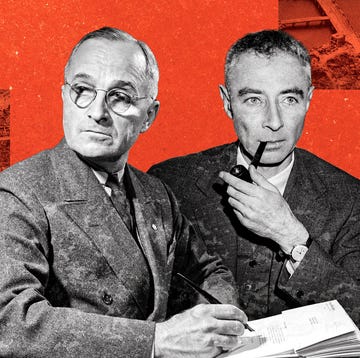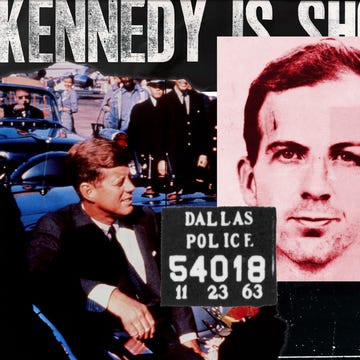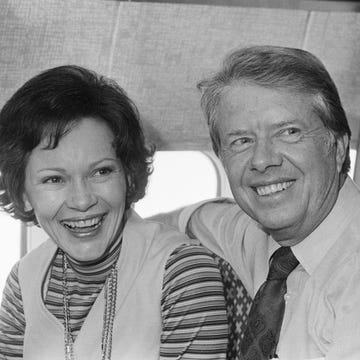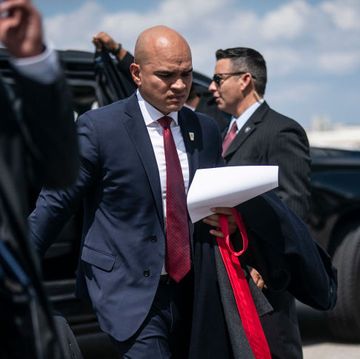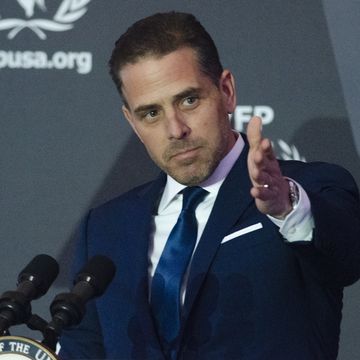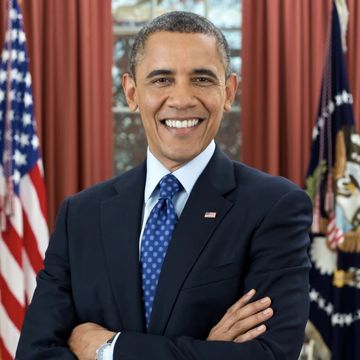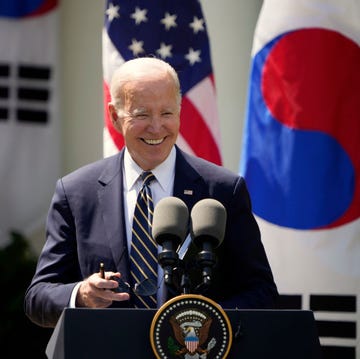(1890-1969)
Who Was Dwight D. Eisenhower?
Dwight D. Eisenhower was appointed U.S. Army chief of staff in 1945. He became the first Supreme Allied Commander of the North Atlantic Treaty Organization (NATO) in 1951. In 1952 he was elected U.S. president. He served two terms before retiring to Gettysburg in 1961. Eisenhower died on March 28, 1969, at the Walter Reed Army Hospital in Washington, D.C.
Early Life
Eisenhower was born on October 14, 1890, in Denison, Texas, to David Jacob Eisenhower and Ida Elizabeth Stover Eisenhower. Dwight was the third of his parents’ seven sons. His parents had moved from Abilene, Kansas, to Denison, Texas, before he was born. In Denison, the family lived in a tiny house near the railroad tracks while David cleaned train engines for a living.
When Eisenhower was a year and a half old, his family moved back to Abilene so David could take a better job at his brother-in-law's creamery.
In Abilene, his 10-month-old brother Paul died of diphtheria when Eisenhower was four years old. Despite the tragedy, he formed happy childhood memories in Abilene that he would cherish throughout his life. Among these were his days playing baseball and football at Abilene High School.
After Eisenhower graduated from high school in 1909, he joined his father and uncle at the Belle Springs Creamery while also moonlighting as a fireman. Eisenhower used the money he earned to pay his younger brother Edgar’s tuition at the University of Michigan. The brothers had a deal: After two years, they’d switch places — with Edgar then working to support Eisenhower's college education. Luckily for Edgar, he never had to live up to his end of the deal.
In 1911, Eisenhower landed an appointment at the United States Military Academy in West Point, New York, where attendance was free of charge. Once again he was a star on the football field until a series of knee injuries forced him to stop playing. In 1915, Eisenhower proudly graduated from West Point and was commissioned as a second lieutenant.
Military Career
After graduation, Eisenhower was stationed in Texas, where he met and started dating 18-year-old Mamie Geneva Doud from Denver, Colorado. The couple married nine months later, on July 1, 1916. Eisenhower was promoted to first lieutenant on his wedding day.
For the first few years of Eisenhower's military career, he and Mamie moved from post to post throughout Texas, Georgia, Maryland, Pennsylvania and New Jersey. In 1917, Mamie gave birth to the couple's first son, Doud Dwight. That same year, the United States entered WWI. Although Eisenhower hoped to be commissioned overseas, he was instead appointed to run a tank training center at Camp Colt in Gettysburg, Pennsylvania. Throughout the war and afterward, Eisenhower continued to rise through the ranks. By 1920, he was promoted to major, after having volunteered for the Tank Corps, in the War Department's first transcontinental motor convoy, the previous year.
In 1921, tragedy struck at home, when the Eisenhowers' firstborn son, Doud Dwight, died of scarlet fever at the age of three. Mamie gave birth to a second son, John Sheldon Doud, in 1922. That year, Eisenhower assumed the role of executive officer to General Fox Conner in the Panama Canal Zone. In 1924, at Conner's urging, Eisenhower applied to the Army's prestigious graduate school, the Command and General Staff School at Ft. Leavenworth, Kansas, and was accepted. He graduated first in his class of 245 in 1926, with a firm reputation for his military prowess.
From 1927 to 1929 Eisenhower toured and reported for the War Department, under General John Pershing. After finishing his tour in 1929, Eisenhower was appointed chief military aide under General Douglas MacArthur. From 1935 to 1939 Eisenhower served under MacArthur as assistant military advisor to the Philippines. Eisenhower returned to the United States in early 1940.
Over the next two years, he was stationed in California and Washington state. In 1941, after a transfer to Fort Sam Houston, Eisenhower became chief of staff for the Third Army. Eisenhower was soon promoted to brigadier general for his leadership of the Louisiana Maneuvers. Late that year he was transferred to the War Plans division in Washington, D.C. In 1942, he was promoted to major general. Just months later, he became commander-in-chief of the Allied Forces and led Operation Torch, the Allied invasion of North Africa.
On D-Day, June 6, 1944, Eisenhower commanded the Allied forces in the Normandy invasion. In December of that year, he was promoted to five-star rank. After Germany's surrender in 1945, he was made military governor of the U.S. Occupied Zone. Eisenhower then returned home to Abilene and received a hero's welcome. A few months later, he was appointed U.S. Army chief of staff. In 1948, he was elected president of Columbia University, a position he held until December of 1950 when he decided to leave Columbia to accept an appointment as first Supreme Allied Commander of the North Atlantic Treaty Organization. While in Paris with NATO, Eisenhower was encouraged by Republican emissaries to run for president of the United States.
U.S. Presidency
In 1952 Eisenhower retired from active service and returned to Abilene to announce his candidacy for the Republican Party nomination. On November 4, 1952, after winning the election by a landslide, Eisenhower was elected the United States' 34th president. His domestic policy picked up where Franklin Roosevelt's New Deal and Harry Truman's Fair Deal programs left off. In foreign policy, Eisenhower made reducing Cold War tensions through military negotiation a main focus of his administration.
In 1953 he orchestrated an armistice that brought peace to South Korea's border. Also that year, Eisenhower made his famous "Atoms for Peace" speech at the United Nations General Assembly. The United States and Russia had both recently developed atomic bombs, and the speech promoted applying atomic energy to peaceful uses, rather than using it for weaponry and warfare. In 1955, Eisenhower met with Russian, British and French leaders at Geneva to further quell the threat of atomic war.
In 1956 Eisenhower was a reelected to a second term, winning by an even wider margin than in his first election, despite the fact that he had just recently recovered from a heart attack. Over the course of his second term, Eisenhower continued to promote his Atoms for Peace program. In his second term, he also grappled with crises in Lebanon and the Suez.
Accomplishments during his two terms include creating the U.S. Information Agency, and establishing Alaska and Hawaii as states. Eisenhower also supported the creation of the Interstate Highway System during his time in office. His other distinctions include signing the 1957 Civil Rights Act and setting up a permanent Civil Rights Commission. Eisenhower was additionally responsible for signing the bill to form the National Aeronautics and Space Administration (NASA).
Poised to leave office in January of 1961, Eisenhower gave a televised farewell address in which he warned the nation against the dangers of the Cold War "military-industrial complex."
Later Life
Following his presidency, Eisenhower retired to a farmhouse in Gettysburg with his wife, Mamie. Although he had resigned his commission as a general when he became president, when he left office his successor, President Kennedy, reactivated his commission. He also kept an office at Gettysburg College for the remainder of his life, where he held meetings and wrote his memoirs.
Eisenhower died on March 28, 1969, at Walter Reed Army Hospital in Washington, D.C., following a long period of suffering from a heart-related illness. In addition to a state funeral in the nation's capital, a military funeral was held in Eisenhower's beloved hometown of Abilene, Kansas.
Watch "Dwight D. Eisenhower: Commander-in-Chief" on HISTORY Vault
QUICK FACTS
- Name: Dwight D. Eisenhower
- Birth Year: 1890
- Birth date: October 14, 1890
- Birth State: Texas
- Birth City: Denison
- Birth Country: United States
- Gender: Male
- Best Known For: Dwight D. Eisenhower, 34th president of the United States, promoted Atoms for Peace at the United Nations General Assembly in order to ease Cold War tensions.
- Industries
- World Politics
- World War II
- U.S. Politics
- World War I
- Journalism and Nonfiction
- Astrological Sign: Libra
- Schools
- Command and General Staff School
- United States Military Academy at West Point
- Abilene High School
- Interesting Facts
- President Dwight D. Eisenhower graduated first in his class at the Command and General Staff School at Ft. Leavenworth in 1926.
- Death Year: 1969
- Death date: March 28, 1969
- Death State: Washington, D.C.
- Death Country: United States
Fact Check
We strive for accuracy and fairness.If you see something that doesn't look right,contact us!
CITATION INFORMATION
- Article Title: Dwight D. Eisenhower Biography
- Author: Biography.com Editors
- Website Name: The Biography.com website
- Url: https://www.biography.com/political-figures/dwight-d-eisenhower
- Access Date:
- Publisher: A&E; Television Networks
- Last Updated: April 13, 2021
- Original Published Date: April 3, 2014
QUOTES
- A people that values its privileges above its principles soon loses both.
- There must be no second class citizens in this country.
- If a danger exists in the world, it is a danger shared by all—and equally…if a hope exists in the mind of one nation, that hope should be shared by all.
- You know, farming looks mighty easy when your plow is a pencil, and you're a thousand miles from the corn field.
- Change based on principle is progress. Constant change without principle becomes chaos.
- The only way to win the next world war is to prevent it.
- You have got to have something in which to believe. You have got to have leaders, organization, friendships, and contacts that help you to believe that, and help you to put out your best.
- The essence of leadership is to get others to do something because they think you want it done and because they know it is worthwhile doing.
- The peace we seek and need means much more than mere absence of war. It means the acceptance of law, and the fostering of justice, in all the world.
- Americans, indeed, all free men, remember that in the final choice a soldier's pack is not so heavy a burden as a prisoner's chains.
- There is—in world affairs—a steady course to be followed between an assertion of strength that is truculent and a confession of helplessness that is cowardly.
- There must be no second-class citizens in this country.



